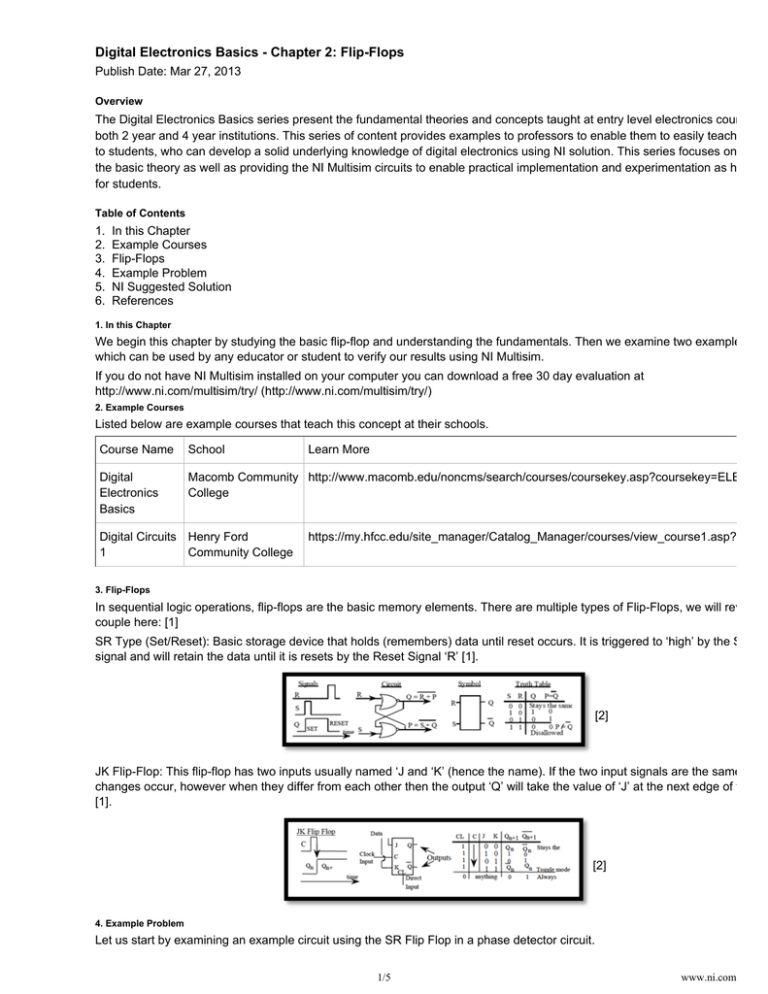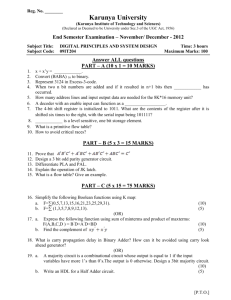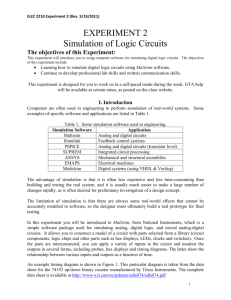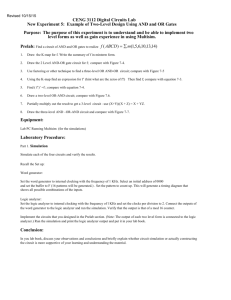Digital Electronics Basics - Chapter 2: Flip-Flops
advertisement

Digital Electronics Basics - Chapter 2: Flip-Flops Publish Date: Mar 27, 2013 Overview The Digital Electronics Basics series present the fundamental theories and concepts taught at entry level electronics courses a both 2 year and 4 year institutions. This series of content provides examples to professors to enable them to easily teach conce to students, who can develop a solid underlying knowledge of digital electronics using NI solution. This series focuses on some the basic theory as well as providing the NI Multisim circuits to enable practical implementation and experimentation as homew for students. Table of Contents 1. 2. 3. 4. 5. 6. In this Chapter Example Courses Flip-Flops Example Problem NI Suggested Solution References 1. In this Chapter We begin this chapter by studying the basic flip-flop and understanding the fundamentals. Then we examine two example circu which can be used by any educator or student to verify our results using NI Multisim. If you do not have NI Multisim installed on your computer you can download a free 30 day evaluation at http://www.ni.com/multisim/try/ (http://www.ni.com/multisim/try/) 2. Example Courses Listed below are example courses that teach this concept at their schools. Course Name School Digital Electronics Basics Macomb Community http://www.macomb.edu/noncms/search/courses/coursekey.asp?coursekey=ELEC-121 College Digital Circuits Henry Ford 1 Community College Learn More https://my.hfcc.edu/site_manager/Catalog_Manager/courses/view_course1.asp?id=215 3. Flip-Flops In sequential logic operations, flip-flops are the basic memory elements. There are multiple types of Flip-Flops, we will review a couple here: [1] SR Type (Set/Reset): Basic storage device that holds (remembers) data until reset occurs. It is triggered to ‘high’ by the Set ‘S’ signal and will retain the data until it is resets by the Reset Signal ‘R’ [1]. [2] JK Flip-Flop: This flip-flop has two inputs usually named ‘J and ‘K’ (hence the name). If the two input signals are the same, no changes occur, however when they differ from each other then the output ‘Q’ will take the value of ‘J’ at the next edge of the clo [1]. [2] 4. Example Problem Let us start by examining an example circuit using the SR Flip Flop in a phase detector circuit. STEP 1: Using NI Multisim, open circuit file “sr_flip_flop.ms12”, you will notice the circuit below: 1/5 www.ni.com STEP 1: Using NI Multisim, open circuit file “sr_flip_flop.ms12”, you will notice the circuit below: STEP 2: Double-click on each of the Oscilloscope instruments XSC1 and XSC2 to open their front panels, then run the simulati You will notice the graphs below: STEP 3: Stop the simulation. Then, double-click on the “Out of Phase” source V2 to open it’s properties. Change the "Delay tim value to equal 0.15ms and then to 0.7 ms and run the simulation for each time. You will notice that the output voltage will increase as the two signals get farther out of phase. Delay time = 0.15 ms: 2/5 www.ni.com Delay time = 0.7 ms: Let us now examine an example circuit utilizing the JK Flip Flop in a divide by 10 ripple down counter. STEP 4: Using NI Multisim, open circuit file “jk_flip_flop.ms12”, you will notice the circuit below [3]: Answer Sub-Step 1: Determine the output states for each flipflop and draw the diagram in comparison to the clock signal. Based on the characteristics of the JK Flip Flop and their connections in the above circuit, we can draw the output signals follows: 3/5 www.ni.com [3] Let us now confirm our results using NI Multisim. STEP 5: Using circuit file “jk_flip_flop.ms12”, double click on the Logic Analyzer instrument to open the front panel, then run the simulation. You will notice the results below which confirm our drawing of the signals above: 5. NI Suggested Solution National Instruments offers a number of products that combine to provide a scalable and powerful teaching platform for educato The solution includes: NI Multisim circuit teaching environment: Combining an intuitive circuit definition environment, with powerful SPICE simulation technology, educators can use NI Multisim to easily teach the ins-and-outs of circuits in a safe environment. NI ELVIS teaching and measurement platform allows educators to provide students with a compact, all-in-one unit for their measurement and analysis needs. Combining an oscilloscope, function generator, DMM, bode analyzer and 8 other instrument into a small platform; it simplifies the laboratory experience for students and lab instructors. 6. References [1] Georgia State University. Department of Physics and Astronomy. Flip-Flops. [ http://hyperphysics.phy-astr.gsu.edu/hbase/electronic/flipflop.html ( http://hyperphysics.phy-astr.gsu.edu/hbase/electronic/flipflop.html)]. (12/03/2013) [2] University of Colorado Boulder. Department of Physics. Digital Electronics I: Logic, Flip-Flops, and Clocks. [ http://www.colorado.edu/physics/phys3330/phys3330_sp12/phys3330_sp12/Lab_Manual_files/Exp_9_Spring12_re.pdf ( http://www.colorado.edu/physics/phys3330/phys3330_sp12/phys3330_sp12/Lab_Manual_files/Exp_9_Spring12_re.pdf)]. (12/03/2013) [3] The Ohio State University. Department of Physics. Lecture 10. [http://www.physics.ohio-state.edu/~gan/teaching/summer04/Lec10.pdf]. (12/03/2013) PRODUCT SUPPORT COMPANY Order status and history (http://www.ni.com/status/) 4/5 www.ni.com Order by part number ( Submit a service request ( http://sine.ni.com/apps/utf8/nios.store?action=purchase_form https://sine.ni.com/srm/app/myServiceRequests) ) About National Instruments ( http://www.ni.com/company/) Manuals (http://www.ni.com/manuals/) Activate a product ( http://sine.ni.com/myproducts/app/main.xhtml?lang=en Drivers (http://www.ni.com/downloads/drivers/) ) Events (http://www.ni.com/events/) Careers (http://www.ni.com/careers/) Alliance Partners (http://www.ni.com/alliance/) Order and payment information ( http://www.ni.com/how-to-buy/) MISSION NI equips engineers and scientists with systems that accelerate productivity, innovation, and discovery. (http://twitter.com/niglobal) ( http://www.facebook.com/NationalInstruments) ( http://www.linkedin.com/company/3433?trk=tyah) (http://www.ni.com/rss/) ( http://www.youtube.com/nationalinstruments) Contact Us (http://www.ni.com/contact-us/) (http://privacy.truste.com/privacy-seal/National-Instruments-Corporation/validation?rid=bc6daa8f-7051-4eea-b7b5-fb24dcd96d95) Legal (http://www.ni.com/legal/) | © National Instruments. All rights reserved. | Site map ( http://www.ni.com/help/map.htm) 5/5 www.ni.com





